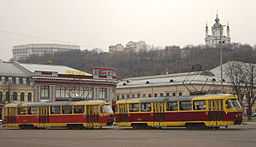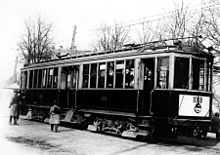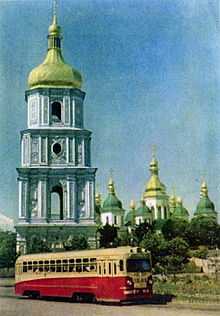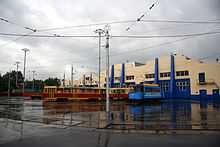Trams in Kiev

The Kiev Tram (Ukrainian: Київський трамвай) is a tram network which serves the Ukrainian capital Kiev. The system was the first electric tramway in the former Russian Empire and the third one in Europe after the Berlin Straßenbahn (tram) and the Budapest tramway. The Kiev Tram system currently consists of 139.9 km (86.9 mi) of track,[1] including 14 km (8.7 mi) two Rapid Tram lines, served by 21 routes with the use of 523 tram cars. However, the system is being neglected, the serviced track length is decreasing at a fast rate and is replaced by buses and trolleybuses.
The Kiev Tram system is operated by the "Kyivpastrans" municipal company which also maintains bus, trolleybus and urban rail transport in Kiev.
History
During the Russian Empire
Before 1886, projects for the construction of a horse-drawn tramway were planned. However, none of these plans had ever proceeded to the construction stage.[2] In 1886, engineer Amand Struve's project was approved for construction. On July 30, 1891, the first horse-drawn tram wagon was set on a track. By August 1, the tram line stretched from the Tsar's Square to the Demiivska Square.[2]
Soon after tram operations were started, many problems arose. The hilly terrain of Kiev presented the largest problem. On Bohdan Khmelnytsky Street, a pair of horses was not enough to pull the trams uphill. Therefore, another two pairs of horses were added, which did not improve the situation. Thus, mechanizing the tram using a steam-powered engine was attempted as a solution to the problem. However, the steam engines produced a lot of noise, which scared the horses and people, and produced a lot of air pollution.[2]
The slew of problems experienced by the trams shocked Struve, who in 1890, had written a letter to the City Administration of Kiev suggesting that for increased safety and easier use, the trams would need to be powered using electric motors.[2] The administration of the Kiev Telegraph service opposed this move since, in their opinion, the electric motors would interfere with the telephone and telegraph systems.[2]
On May 3, 1892, the first two trams with electric motors arrived in Kiev. They were built by the Struve brothers in a factory located near Moscow, based on American designs. On the same day, the engines were tested on the flat Sahaydachny Street, and once more, on May 8, on the track from Podil Street to Khreshchatyk Street.
In 1893, the money earned by these electric trams exceeded the cost to maintain the trams. Furthermore, the electric trams were used whenever the horse-drawn or steam-powered trams had difficulty. Nevertheless, the system's horse-drawn trams were in use until 1895, and the last steam-powered cars ran until 1904, when a diesel electric station, on the so-called Dachnaya (Dachna) to Puschya-Vodytsia line was built. This station had lasted until the 1930s. These trams required very little power, which caused any electric trams, which used the line, to move so slowly that the passengers could get on and off the tram, while the tram remained in motion.
A long tram line, about 17 versts (18 kilometres) long, was laid from the Poshtova Square in the Podil neighbourhood, over the Dnieper on the Nicholas Bridge, through the Peredmostna and Nikolska Slobodka neighbourhoods, and to the neighbouring town of Brovary. The line was used until the mid-1930s, and was a one-way line with side-skirts for oncoming trams to drive into. This had made the trip even longer than it really was. The cost was 35 kopecks, a fair amount of money at the time.[2] Nevertheless, the trams were always packed with passengers.


By 1893, the city's trams easily climbed the many steep streets of Kiev, including the Proreznay (Prorezna), Karavayevskaya (Karavaievs’ka, now the Ploscha L’va Tolstoho Street) and even the Kruglouniversitetskaya (Kruhlouniversitets’ka) Streets. In 1893, the Elektrichestvo journal wrote:
If Kiev's terrain had not been so unique, then it would have taken many years before electricity would have been used to power the trams.[3]— Elektrichestvo journal
A major problem of the tram drivers at the time was the rolling stock used. When the city's railroad stock holder Lazar Brodsky died, the stocks were transferred to the Belgian auction firm, and the tram system began running on the Belgian Pullman wagons, with soft, sail-type cloth seats. But not these, nor the earlier seats on the German wagons, gave the tram drivers any comfort while standing in wind, rain, or snow, on the driver's platform on the tram.
In Soviet Ukraine
After the Russian Revolution and the Russian Civil War, reconstruction of the tram system began. The old and outdated tram wagons required restoration as the industry of the country could not manufacture new wagons. The train wagons' reconstruction was carried out in the main tram depot of the system, the Dombal Depot. From 1928-1932, 80 two-axel motor tram wagons and 65 regular train wagons were manufactured for Kiev, and since 1932, the depot started producing four-axel tram wagons, due to Kiev's geographical relief and climate. On the tram wagons, the conductors place was not warmed during the winter, however, was separated from the passenger part of the wagon.
On March 13, 1961, a major landslide hit the city's Podilske Tram Depot, burying it in clay sludge and killing most personnel on site. Additionally, dozens of people died in the tram cars and buses caught by the landslide and subsequent short circuit on the street intersection immediately next to the depot.
Lines, routes and depots

There are 23 different tram routes active[4](including 5 on the Rapid Tram lines) in two networks - on the Right and Left Banks of Kiev, respectively. There are active tram lines in 9 out of 10 city raions (excluding the Holosiiv Raion).
There are 3 rolling stock maintenance depots and dozens of infrastructure units in the system.
Rolling stock
The Kiev tram system uses many different tram cars and types, with some being designed in Moscow and manufactured in Riga, some being manufactured by the ČKD Tatra company in Prague, and with some being manufactured right in the city of Kiev. The following data incorporates only some tram cars used by the system.
| Car type [5] | Numbers | Years in service | Routes |
|---|---|---|---|
| MTV-82 [6] | 1201–1305, 1321–1387, 1501–1582 | 1949–1984 | Almost all |
| KTV-55 [7] | 1110–1119, 1123–1126 | 1955–1984 | 1, 3, 6, 12, 14, 15, 16, 17, 23 |
| KTP-55 [8] | 1001–1099 | 1955–1984 | 1, 3, 5, 6, 7, 12, 17, 18, 19, 23 |
| KTV-55-2 [7] | 2001–2081 | 1955–1987 | Stub-ended (1, 3, 4, 8, 16, 29, 30, 32);
Some ordinary (5, 6, 9, 10, 23, 24) |
| Tatra T6B5 | 001-077, 100-101, 301-318 | 1985 –Present | Almost all |
| Tatra T3 "Progress" | 5613, 5614, 5673, 5905, 5916, 5977, 5981, 5992, 5994 | 2003–Present | 12, 8, 23, 25, 29, 32, 33 |
| K1 | 320-328 | 2011-Present | 3 |
| K1M8 | 500-503 | 2011-Present | 3 |
References
- Notes
- Footnotes
- ↑ For a 2004 plan of the Kiev tram, please see mashke.org
- ↑ 2.0 2.1 2.2 2.3 2.4 2.5 Kalachevsky, Vladimir. "The first – in Kiev!". Autocentre (in Russian). Retrieved June 26, 2006.
- ↑ Anisimov, Aleksandr (2002). Kiev and Kievans (in Russian). Kurch. pp. 88–89. ISBN 966-96120-1-2.
- ↑ "Маршрутна мережа". Retrieved 14 September 2014.
- ↑ Note: Not all of the tram cars of the system are listed here. Mashkevich, Stefan. "Photo Galleries" (in Russian). Retrieved November 17, 2006.
- ↑ Moskovsky Tramvay (MTV) was designed in Moscow and manufactured in Riga.
- ↑ 7.0 7.1 Kievsky Tramvay (KTV) was manufactured by the Dzerzhinsky Kiev Electric Transportation Plant (KZET)
- ↑ Kievsky Tramvay Pritsepnoy (KTP) was manufactured by the Dzerzhinsky Kiev Electric Transportation Plant (KZET)
- Bibliography
- Mashkevych, Stefan. "In memory of Kiev Trams, by Stefan Mashkevich". Retrieved June 26, 2006.
- Kalachevsky, Vladimir. "The first – in Kiev!". Autocentre (in Russian). Retrieved June 26, 2006.
- Anisimov, Aleksandr (2002). Kiev and Kievans (in Russian). Kurch. pp. 88–89. ISBN 966-96120-1-2.
- Further reading
- Mashkevych, Stefan. Tram Kopecks in Zerkalo Nedeli, October 16–22, 2004. Available in Russian and Ukrainian
- Rozhanovsky, Viktor. Struve: Uphill on the Aleksandrovsky Spusk in Zerkalo Nedeli, October 24–30, 1998. Available in Russian
- Kochevykh, Oleg; Stefan Mashkevich. "Our dear friend the tram". Interesting Kiev (in Russian). Retrieved November 17, 2006.
- Polischuk, Nikolai; Stefan Mashkevich (February 3, 2006). Трамвай, уходящий в чащу. Gazeta po-Kievsky (in Russian).
External links
| Wikimedia Commons has media related to Kiev tram. |
- "Kyivpastrans" official web site (Ukrainian)
- In memory of Kiev Trams – by Stefan Mashkevich (English)/(Russian)
- noosphere.com.ua – Fast tram №2 in Kiev (Russian)
| |||||||||||||||
| ||||||||||||||||||
